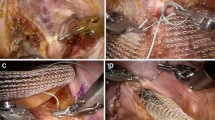Abstract
Aims
Anterior mesh rectopexy is a novel surgical technique for the treatment of complete rectal prolapse, a common disorder in female elderly patients. Aim of the study was to evaluate functional outcomes after ventral mesh rectopexy and conventional suture rectopexy.
Patients and methods
Forty patients have been enrolled in this prospective study. Patients were divided into two groups: 20 patients (group A) had a conventional suture rectopexy with a standard technique and 20 patients (group B) underwent an anterior mesh rectopexy. Each patient had a clinic and defecographic diagnosis of full-thickness rectal prolapse, which was further investigated with manometry and clinical questionnaires (Wexner Constipation and Incontinence Score, Rome III criteria). Postoperative outcomes were evaluated through clinical questionnaires, a rigid rectosigmoidoscopy and a defecography, 1 year after surgery.
Results
Preoperative Wexner constipation score was greater than 15 in all the patients (21 in group A and 22 in group B); median postoperative score was 15 in group A and 11 in group B, and the difference was significant. Median preoperative incontinence score was 11 in group A and 12 in group B; median postoperative score was 9 in group A and 6 in group B. Three patients experienced recurrence in group A and only 1 patient in group B.
Conclusion
Ventral mesh rectopexy is feasible, safe and effective for the treatment of full-thickness rectal prolapse in a well-fit geriatric population. Better functional results have been achieved compared with conventional suture technique with a trend toward a lower recurrence rate.
Similar content being viewed by others
References
Felt-Bersma RJ, Cuesta MA (2001) Rectal prolapse, rectal intussusception, rectocele, and solitary rectal ulcer syndrome. Gastroenterol Clin N Am 30:199–222
D’Hoore A, Vanbeckevoort D, Penninckx F (2008) Clinical, physiological and radiological assessment of rectovaginal septum reinforcement with mesh for complex rectocele. Br J Surg 95:1264–1272
Parks AG, Swash M, Urich H (1977) Sphincter denervation in anorectal incontinence and rectal prolapse. Gut 18:656–665
Azimuddin K, Khubchandani IT, Rosen L et al (2001) Rectal prolapse: a search for the best operation. Am Surg 67:622–627
D’Hoore A, Cadoni R, Penninckx F (2004) Long-term outcome of laparoscopic ventral rectopexy for total rectal prolapse. Br J Surg 91:1500–1505
Luglio G, Masone S, Quarto G et al (2013) Functional results after TME: J-pouch vs straight coloanal anastomosis and role of neoadjuvant radiochemotherapy. Ann Ital Chir 84:571–574
Giglio MC, Persico M, Quarto G et al (2013) Intersphinteric resection for rectal cancer: role in fecal continence and quality of life. Ann Ital Chir 84:287–290
De Palma GD, Luglio G (2015) Quality of life in rectal cancer surgery: what do the patient ask? World J Gastrointest Surg 7:349–355
West NP, Kennedy RH, Magro T et al (2014) Morphometric analysis and lymph node yield in laparoscopic complete mesocolic excision performed by supervised trainees. Br J Surg 101:1460–1467
Milone M, Elmore U, Di Salvo E et al (2015) Intracorporeal versus extracorporeal anastomosis. Results from a multicentre comparative study on 512 right-sided colorectal cancers. Surg Endosc 29:2314–2320
Luglio G, De Palma GD, Tarquini R et al (2015) Laparoscopic colorectal surgery in learning curve: role of implementation of a standardized technique and recovery protocol. A cohort study. Ann Med Surg (Lond) 4:89–94
Luglio G, Nelson H (2010) Laparoscopy for colon cancer: state of the art. Surg Oncol Clin N Am 19:777–791
Kim DS, Tsang CB, Wong WD et al (1999) Complete rectal prolapsed. Evolution of management and results. Dis Colon Rectum 42:460–468
Gourgiotis S, Baratsis S (2007) Rectal prolapse. Int J Dis 22:231–243
Slawik S, Soulsby R, Carter H et al (2008) Laparoscopic ventral rectopexy, posterior colporrhaphy and vaginal sacrocolpopexy for the treatment of recto-genital prolapse and mechanical outlet obstruction. Colorectal Dis 10:138–143
Portier G, Iovino F, Lazorthes F (2006) Surgery for rectal prolapse. Dis Colon Rectum 49:1136–1140
Luukkonen P, Mikkonen U, Järvinen H (1992) Abdominal rectopexy with sigmoidectomy vs. rectopexy alone for rectal prolapse: a prospective, randomized study. Int J Colorectal Dis 7:219–222
D’Hoore A, Penninckx F (2006) Laparoscopic ventral recto (colpo) pexy for rectal prolapse: surgical technique and outcome for 109 patients. Surg Endosc 20:1919–1923
Author information
Authors and Affiliations
Corresponding author
Ethics declarations
Conflict of interest
The authors declare that they have no conflict of interest.
Statement of human and animal rights
This article does not contain any studies with animals performed by any of the authors.
Informed consent
For this type of study, formal consent is not required.
Rights and permissions
About this article
Cite this article
Luglio, G., Tarquini, R., Giglio, M.C. et al. Ventral mesh rectopexy versus conventional suture technique: a single-institutional experience. Aging Clin Exp Res 29 (Suppl 1), 79–82 (2017). https://doi.org/10.1007/s40520-016-0672-9
Received:
Accepted:
Published:
Issue Date:
DOI: https://doi.org/10.1007/s40520-016-0672-9




